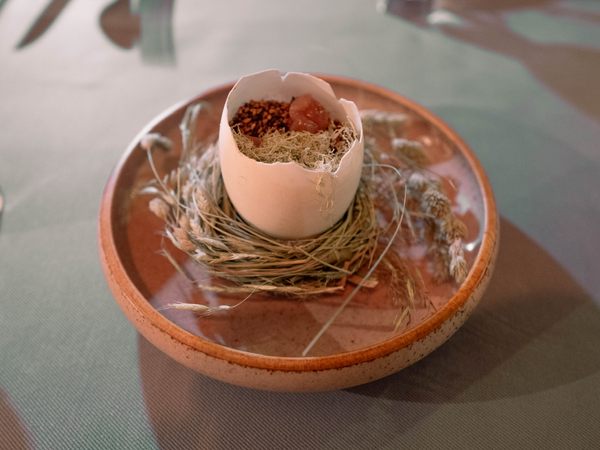Picture this: the walls are covered in a ceiling-high collage of sea shells, driftwood, and animal skulls. Gene Wilder’s voice is singing “Pure Imagination” from the Willy Wonka soundtrack. There’s a clam on the table that may bite back when you attempt to eat it. And at times when a new course appears, the handful of other diners in the room gasp—often in delight, occasionally in alarm.
Honey Badger has been something of a dark horse in New York’s fine dining since it opened in 2017. Despite a significant online presence and attention by international chefs, it’s never earned so much as a nod from the city’s restaurant critics. For starters, it’s tucked away in a residential slice of Prospect Leffert Gardens with a kitchen barely larger than that of an average apartment. Much of the actual cooking is done with a blowtorch and a toaster oven.
Anyone expecting a conventional fine dining experience may want to look elsewhere. While many of the city’s tasting rooms are slickly coordinated affairs, with armies of waitstaff to swap out each fork, dining at Honey Badger feels more akin to crashing a highly eccentric family dinner party. But what this “wild-to-table” restaurant offers is the chance to try ingredients you may not find anywhere else. If scooping salty-sweet ice cream out of a marrow bone appeals, this must be the place.
Your hosts for the evening are Fjölla Sheholli, the Kosovo-born chef, and her husband Junayd Juman, a Trinidad-born industrial designer-turned-restaurateur. Both forage, hunt, ferment, pickle, and otherwise prepare virtually everything on the everchanging, hyper-local menu—which may include everything from homemade pasta and croissants, to chawanmushi and tempura. It leans heavily on New Nordic–influenced cooking, although there’s really nothing else like it.
There might be limpets harvested from Maine’s rocky coastline with cordyceps mushrooms, angelica tree buds with water buffalo milk fermented with summer peppers, or dark orange–yolked custard served in duck pond eggs with shad roe. Very little goes to waste. If you see a set of red deer antlers on the decorative wall of bones, you can bet the meat, organs, and blood have all appeared on the menu.
While cocktails made with ingredients like house-preserved pine buds are exceptional, the wine selection feels less thoughtful and almost at odds with the locavore ethos of the restaurant. Arguably, the more interesting option is the non-alcoholic drink pairing, which consists of waters from 1,000-year-old aquifers and Norwegian fjords poured into crystal goblets. There’s a shocking degree of variation between the saline, mineral glacial run-off and the cool, smooth taste of water that has rested in limestone caverns. How you feel about a $70 water pairing may determine a lot about how much you enjoy the restaurant as a whole.
At times, the restaurant veers into macabre performance art territory. You may be served a partridge head, feathers intact as though it were still alive, and asked to scoop out its brains. Dessert might appear as ice cream inside a former colony of slipper snails, which you pry apart with your fingers to obtain the briny treat within. It’s not always traditionally delicious, but it’s always ambitious. And even though you’ll be served a dozen-odd courses, you may still want a snack on the way home. Some dishes are formidable in impact, but none could be called formidable in size.

